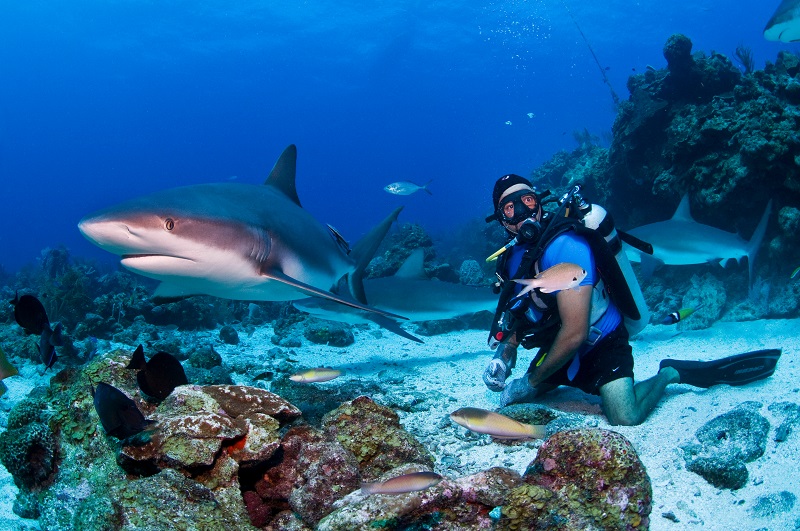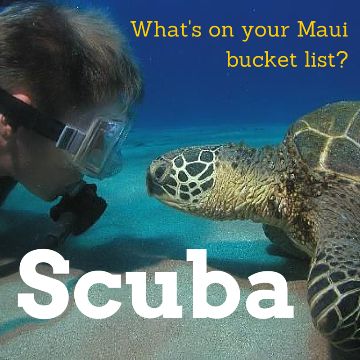
If you’re planning a trip to Maui anytime soon, you should know that it is home to more than 40 species of shark.
While this fact might scare thousands of people into seeking alternative holiday destinations, others might find it fascinating as they book boat trips to see the many sharks of Maui.
But what sharks are commonly found in Maui, and what sets them apart from the rest?
Let’s take a look at the top ten sharks that can be found near Maui Island.
Meet the Top Ten Sharks Found in the Waters of Mau
Let’s jump straight into our list of the top ten sharks you can see while shark diving in maui.
#1: Tiger Sharks
We’re starting off our list with the largest and most aggressive shark, the tiger shark – or Galeocerdo Cuvier.
Ranging between 14 to 16 feet, Tiger sharks are gray or tan in color and have distinct spots that later form stripes when the sharks reach their adult years. These are not, however, always visible.
Here are a few more facts about Tiger sharks:
-
They have round, broad snouts that house large serrated teeth
-
Tiger shark mothers give birth to anywhere between 10 and 80 pups every three years
-
These sharks are found in both coastal waters and the open oceans and can be seen between 300 and 2,500 feet below the surface of the water.
Tiger sharks eat smaller animals and fish, dead or alive
They have earned themselves the nickname “Garbage Can of the Sea.”
These sharks are hunted by humans for their skin, liver oil, and meat
Tiger sharks have no known predators other than humans
#2: Scalloped Hammerhead Sharks
The Scalloped Hammerhead shark, or Sphyrna Lewini, is commonly seen in the waters off Maui and can grow to an impressive length of seven to 14 feet long.
They are gray, have flat heads, and a noticeable indentation on the center and sides of their flat hammer-like heads, earning themselves the name “Scalloped Hammerheads.”
Here are a few more interesting facts about Scalloped Hammerhead sharks:
- They have eyes and gills on each side of their heads
- Scalloped Hammerhead sharks are critically endangered
- These sharks are pregnant for around a year and have between 12 and 38 pups
- They live offshore and eat reef fish, smaller sharks, and crustaceans
- Humans are the number one predators of scalloped sharks and hunt them for their skin and meat
#3: Smooth Hammerhead Shark
Also known as Sphyrna Zygaena, the Smooth Hammerhead shark is the more common Hammerhead that we know and grows up to between eight and 13 feet in length.
They are typically gray, have flattened heads, and do not have the indentations that we see in Scalloped Hammerheads.
Here are a few other juicy bits of information about the Smooth Hammerhead shark:
- Smooth hammerhead sharks carry their young for between 10 and 11 months and give birth to around 20 to 50 pups at a time
- They are migratory and move to warmer waters when Winter hits
- Hammerheads typically frolic between 110 ad 225 feet below the surface of the ocean
- They eat fish, rays, other smaller sharks, and also crustaceans
- These sharks, too, are prey for humans for their oil, skin, meat, and fins
#4: Galapagos Shark
The Galapagos shark, or Carcharhinus Galapagensis, is the second largest shark found in the waters around Maui and can grow up to 12 feet long.
These sharks are brown-gray on their dorsal side, while their bellies are white. Galapagos sharks have an easily identifiable ridge between the first and second dorsal fins, and the outer edges of their tails are dark gray.
Here are a few more facts about the Galapagos shark:
- They have short, wide snouts
- Galapagos sharks are viviparous, which means that they give birth to live young
- The average gestation period of a Galapagos shark is around one year, with the mother birthing between 6 and 16 pups every three years
- Galapagos sharks are found in clear, warm waters around the reefs and continental shelves surrounding Maui
- These sharks are often hunted by humans for their skin, fins, and meat
#5: Blacktip Shark
The Blacktip shark, or Carcharhinus Limbatus, is a smaller shark and grows to about eight feet.
They are gray in color and have black edging on their pectoral and dorsal fins. Their snouts are pointed, and their bodies are shaped like that of torpedoes.
Here are a few more facts about Blacktip sharks:
- Males and females form their own schools
- They give birth to four or five pups at a time
- They are most commonly found 40 to 210 feet below the surface
- Blacktip sharks eat fish, octopus, and squid
- They are also hunted by humans for their meat and fins
#6: Sandbar Shark
Sandbar sharks, or Carcharhinus Plumbeus, get their name from their tendency to swim near the sandy bottoms of the ocean.
They are gray or tan colored and have a high-set dorsal fin that sets them apart from other sharks.
Here are a few more facts about Sandbar sharks:
- They can grow up to eight feet long
- Sandbar sharks have short, round snouts
- They give birth to between six to 13 pups
- Female Sandbar sharks prefer shallower waters (around 225 feet below the surface)
- These sharks are commonly found around continental shelves and in bays and harbors
- They eat reef fish, mollusks, octopus, and crustaceans
- Like many other sharks, humans are the biggest predators of Sandbar sharks
#7: Bignose Shark
Bignose sharks get their name from – yup, you guessed it – their round, often blunt snouts. They are gray and can be up to around nine feet long. Carcharhinus Altimus, or the Bignose shark, is a near-threatened species.
Here are a few more facts about these fascinating sharks with their easily identifiable nasal flaps:
- They are found anywhere between 90 to 1200 feet beneath the ocean surface
- Bignose sharks typically lurk near the edges of the continental shelf, while the younger sharks prefer shallow waters
- They are prey for Great White sharks and eat deepwater fish, other smaller sharks, and rays
- Bignose sharks have a gestational period of about ten months and give birth to as many as 11 pups
#8: Gray Reef Shark
The Gray Reef shark, or Carcharhinus Amblyrhynchos, is known to grow up to six feet long. They are gray and have a distinct white line or streak down their dorsal fin. Simming in large groups, Gray Reef sharks prefer to hunt for their prey alone.
Here are a few more facts about Gray Reef sharks:
- They only breed when they are around eight years old, and birth between one to six pups
- Gray Reef sharks can live up to 25 years
- They are found in coral reefs, stronger currents, and rough terrains around 900 feet deep
- These sharks are common worldwide
- Gray Reef sharks eat fish, cephalopods, and crustaceans
- They are prey to Hammerheads, Tiger Sharks, and also humans who hunt them for their meat
#9: Blacktip Reef Shark
Carcharhinus Melanopterus, more commonly known as the Blacktip Reef shark, is around six feet long and can be found near the coastline of Maui, hiding on the edges of the many coral reefs making up the continental shelf.
Here are a few more facts about these light-brown colored sharks:
- Blacktip Reef sharks are found just 100 feet below the surface
- These sharks have short, round snouts that hide thousands of angled, serrated teeth that are responsible for quite a nasty bite
- Female Blacktip Reef sharks have between two and four pups at a time
- They eat small fish and other invertebrates that are found on reefs
- They have no predators but are hunted by humans for their meat and fins
#10: Whitetip Reef Shark
Last up on our list is the most common shark, the Whitetip Reef shark or Triaenodon Obesus. This shark is commonly seen on the coast of Maui and is often responsible for shark attacks. They can grow up to five to seven feet long and are gray with white-tipped dorsal and tail fins.
Here are a few more details about the Whitetip Reef shark:
- These sharks have slender bodies and flattened heads and feature brow ridges that help distinguish them from other sharks
- They have gestational periods of only five months, giving birth to between one and five pups
- Whitetip Reef sharks eat fish, crustaceans, and octopus and swim 25 to 130 feet below the surface
- They can live for more than 25 years
- The biggest predator of a Whitetip Reef shark is the Tiger Shark
- Sadly, humans hunt these sharks for their meat
Conclusion
Sharks are fascinating creatures, and if these facts about the top ten sharks in Maui are anything to go by, we are sure that many more people will be booking trips to Maui for their one-in-a-lifetime chance to see some of these majestic beasts in the flesh.
Use our list as a guide to help differentiate between the different types of sharks and also see how many you can spot when you visit Maui.
Happy shark spotting!





